Grouping Neural Network-Based Smith PID Temperature Controller for Multi-Channel Interaction System
Abstract
:1. Introduction
- (1)
- Based on the first-order plus dead-time (FOPDT) transfer function model, a discrete multi-channel mathematical model of the interaction system is established.
- (2)
- A grouping neural network (Grouping-NN) is proposed to be used for system identification of the multi-channel interaction environment.
- (3)
- Combine two Grouping-NNs for updating the time-delay model and the model without time delay of the Smith predictor to optimize the PID controller.
2. Preliminary
2.1. The Structure of Temperature Control System
2.2. The Transfer Function of Multi-Channel Heating System
3. Proposed Method
3.1. PID Controller
3.2. Grouping Neural Network Identifier
| Algorithm 1 Grouping-NN for Multi-Channel System Identification |
| 1: Initialization: Grouping-NN weights and ; 2: Initialization: sparse matrix and ; Input: Control data vector: ; Input: Measurement vector: Output: Weights matrix and ; Output: Estimated vector ; 3: while do 4: Normalised network input: ; 5: Layer 1 forward propagation: ; 6: Using activation function on hidden layer: ; 7: Layer 2 forward propagation with linear function: 8: Calculate the partial derivative of the loss function: 9: Backward propagating the err: 10: Update weights, the process needs to be multiplied by the sparse matrix and : 11: for range of j do 12: for range of p do 13: 14: end for 15: end for 16: for range of i do 17: for rang of j do 18: 19: end for 20: end for 21: Buffering the data and 22: ; 23: end while |
3.3. Grouping-NN-Based Smith Predictor
| Algorithm 2 Grouping-NN-based Smith Predictor |
| 1: Initialization: PID parameters , , ; 2: Initialization: buffer of measurement data and control data Input: Measured vector ; Input: Reference vector ; Output: Controller output vector ; 3: while do 4: Using Algorithm 1 with input and with output NN1; 5: Using Algorithm 1 with input and with output NN2; 6: Updating neural network weights; 7: Calculate the predicted compensation: ; 8: Calculate the input vector of PID: ; 9: Calculate PID output using Equations (8) and (9); 10: Buffer PID outputs and measured values; 11: ; 12: end while |
4. Simulation
4.1. Preparation of Simulation
4.2. Simulation Result of Identifier
4.3. Simulation Result of Controller
5. Experiment
5.1. Experiment Setting
5.2. Experiment Results and Analysis
6. Conclusions
Author Contributions
Funding
Data Availability Statement
Conflicts of Interest
References
- Zhang, J.; Xie, J.H.; Wang, Y.R. The application and the development trend of the measurement and control system in the spacecraft vacuum thermal test. Spacecr. Environ. Eng. 2012, 29, 263–267. [Google Scholar]
- Almeida, J.S.; Santos, M.B.; Panissi, D.L.; Garcia, E.C. Effectiveness of low-cost thermal vacuum tests of a micro-satellite. Acta Astronaut. 2006, 59, 483–489. [Google Scholar] [CrossRef]
- Salleh, N.; Daud, S.M.; Sabri, S.F.; Ahmad@Salleh, N.A.; Adam, M.Z. Enhancing Temperature Control Method of Thermal Vacuum Chamber for Satellite Testing Using Optimization Algorithm: A Review. J. Teknol. 2016, 78, 5–7. [Google Scholar] [CrossRef]
- Elshaer, A.M.; Soliman, A.; Kassab, M.; Hawwash, A. Experimental and numerical investigations of an open-cell copper foam (OCCF)/phase change material (PCM) composite-based module for satellite avionics thermal management in a thermal vacuum chamber (TVC). J. Energy Storag. 2024, 75, 109572. [Google Scholar] [CrossRef]
- Werkhausen, A.D.; Hey, H. Temperature transition optimization in cryogenic systems: Application to liquid nitrogen expenditure reduction in a thermal vacuum chamber case study. Appl. Therm. Eng. 2024, 236, 121863. [Google Scholar] [CrossRef]
- Jang, B.; Lee, W.; Lee, J.J.; Jin, H. Artificial neural network-based temperature prediction of a lunar orbiter in thermal vacuum test: Data-driven reduced-order models. Aerosp. Sci. Technol. 2024, 145, 108867. [Google Scholar] [CrossRef]
- Zhang, X.; Wu, L.; Liu, H.; Feng, J.; Xu, M.; Cheng, R. Research and Verification of Multi-Satellite Thermal Vacuum Test Method. In Proceedings of the 2020 International Conference on Sensing, Measurement & Data Analytics in the era of Artificial Intelligence (ICSMD), Xi’an, China, 15–17 October 2020; pp. 347–351. [Google Scholar] [CrossRef]
- Park, S.; Kim, S. Nonlinear Model Predictive Control of Thermal Vacuum Chamber Temperature. Int. J. Aeronaut. Space Sci. 2023, 25, 213–228. [Google Scholar] [CrossRef]
- Guo, J.-C.; Li, F.-Y.; Chen, A.-R.; Zhang, L.-H.; Liu, S.-W. Automatic Temperature Control Design for Thermal Vacuum Tests Based on Fuzzy PID Control. In Proceedings of the 2019 International Conference on Quality, Reliability, Risk, Maintenance, and Safety Engineering (QR2MSE), Zhangjiajie, China, 6–9 August 2019; pp. 186–194. [Google Scholar]
- Zhan, H.; Sun, Y.; Liu, D.; Liu, H. Adaptive neural network PID controller design for temperature control in vacuum thermal tests. In Proceedings of the 2016 Chinese Control and Decision Conference (CCDC), Yinchuan, China, 28–30 May 2016; pp. 458–463. [Google Scholar] [CrossRef]
- Ziegler, J.G.; Nichols, N.B. Optimum settings for automatic controllers. Trans. Am. Soc. Mech. Eng. 1942, 64, 759–765. [Google Scholar] [CrossRef]
- Liu, Z.; Liu, Z.; Liu, J.; Wang, N. Thermal management with fast temperature convergence based on optimized fuzzy PID algorithm for electric vehicle battery. Appl. Energy 2023, 352, 121936. [Google Scholar] [CrossRef]
- Han, S.Y.; Dong, J.F.; Zhou, J.; Chen, Y.H. Adaptive Fuzzy PID Control Strategy for Vehicle Active Suspension Based on Road Evaluation. Electronics 2022, 11, 921. [Google Scholar] [CrossRef]
- Abdelwanis, M.I.; El-Sousy, F.F.M.; Ali, M.M. A Fuzzy-Based Proportional Integral Derivative with Space-Vector Control and Direct Thrust Control for a Linear Induction Motor. Electronics 2023, 12, 4955. [Google Scholar] [CrossRef]
- Ding, Y.; Ren, X.; Zhang, X.; Liu, X.; Wang, X. Multi-Phase Focused PID Adaptive Tuning with Reinforcement Learning. Electronics 2023, 12, 3925. [Google Scholar] [CrossRef]
- Huang, H.; Zhang, S.; Yang, Z.; Tian, Y.; Zhao, X.; Yuan, Z.; Hao, S.; Leng, J.; Wei, Y. Modified Smith fuzzy PID temperature control in an oil-replenishing device for deep-sea hydraulic system. Ocean. Eng. 2018, 149, 14–22. [Google Scholar] [CrossRef]
- Feliu-Batlle, V.; Rivas-Perez, R. Control of the temperature in a petroleum refinery heating furnace based on a robust modified Smith predictor. ISA Trans. 2021, 112, 251–270. [Google Scholar] [CrossRef] [PubMed]
- Pan, Y.; Xie, J.; Zhang, C.; Zhu, X.; Zhao, P. High efficiency far-infrared barrel heating control with excess heat prediction based on generalized predictive control in injection molding. Int. J. Heat Mass Transf. 2024, 218, 124756. [Google Scholar] [CrossRef]
- Xu, L.; Chen, L.; Xiong, W. Parameter estimation and controller design for dynamic systems from the step responses based on the Newton iteration. Nonlinear Dyn. 2015, 79, 2155–2163. [Google Scholar] [CrossRef]
- Tutunji, T.A. Parametric system identification using neural networks. Appl. Soft Comput. 2016, 47, 251–261. [Google Scholar] [CrossRef]
- Hagiwara, T.; Yamada, K. A design method of modified PID controllers for multiple-input/multiple-output plants. IFAC Proc. Vol. 2008, 41, 5825–5830. [Google Scholar] [CrossRef]
- Hagiwara, T.; Yamada, K.; Ando, Y.; Murakami, I.; Aoyama, S.; Matsuura, S. A design method for modified PID control systems for multiple-input/multiple-output plants to attenuate unknown disturbances. In Proceedings of the 2010 World Automation Congress, Kobe, Japan, 28–30 May 2010; pp. 1–6. [Google Scholar]
- Gopmandal, F.; Ghosh, A. LQR-based MIMO PID control of a 2-DOF helicopter system with uncertain cross-coupled gain. IFAC-PapersOnLine 2022, 55, 183–188. [Google Scholar] [CrossRef]
- Carlucho, I.; De Paula, M.; Acosta, G.G. An adaptive deep reinforcement learning approach for MIMO PID control of mobile robots. ISA Trans. 2020, 102, 280–294. [Google Scholar] [CrossRef]
- Ahmad, M.A.; Azuma, S.-I.; Sugie, T. Performance analysis of model-free PID tuning of MIMO systems based on simultaneous perturbation stochastic approximation. Expert Syst. Appl. 2014, 41, 6361–6370. [Google Scholar] [CrossRef]
- Boyd, S.; Hast, M.; Strm, K.J. MIMO PID tuning via iterated LMI restriction. Int. J. Robust Nonlinear Control. 2016, 26, 1718–1731. [Google Scholar] [CrossRef]
- Wang, Y.; Ding, F. Novel data filtering based parameter identification for multiple-input multiple-output systems using the auxiliary model. Automatica 2016, 71, 308–313. [Google Scholar] [CrossRef]

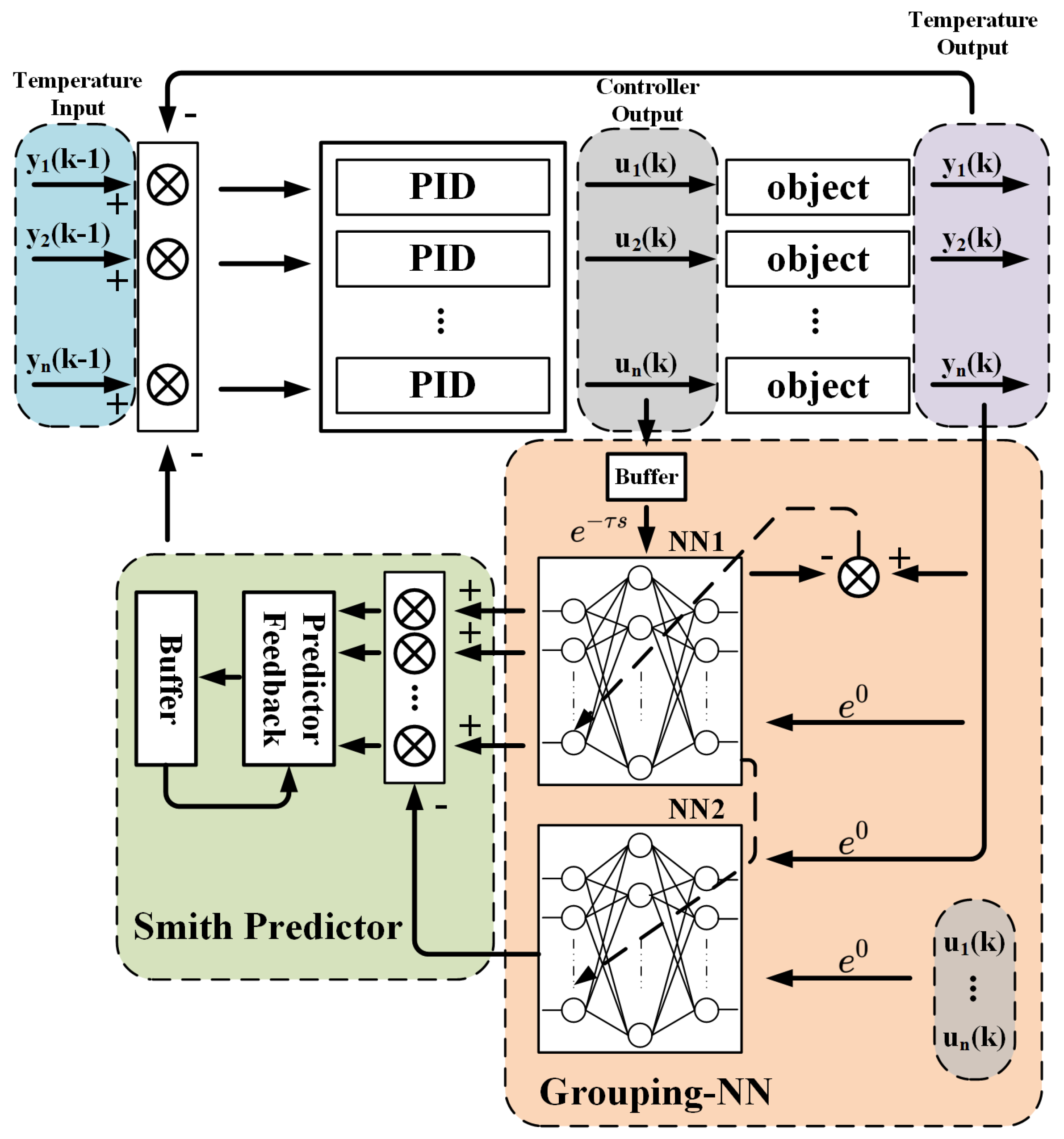

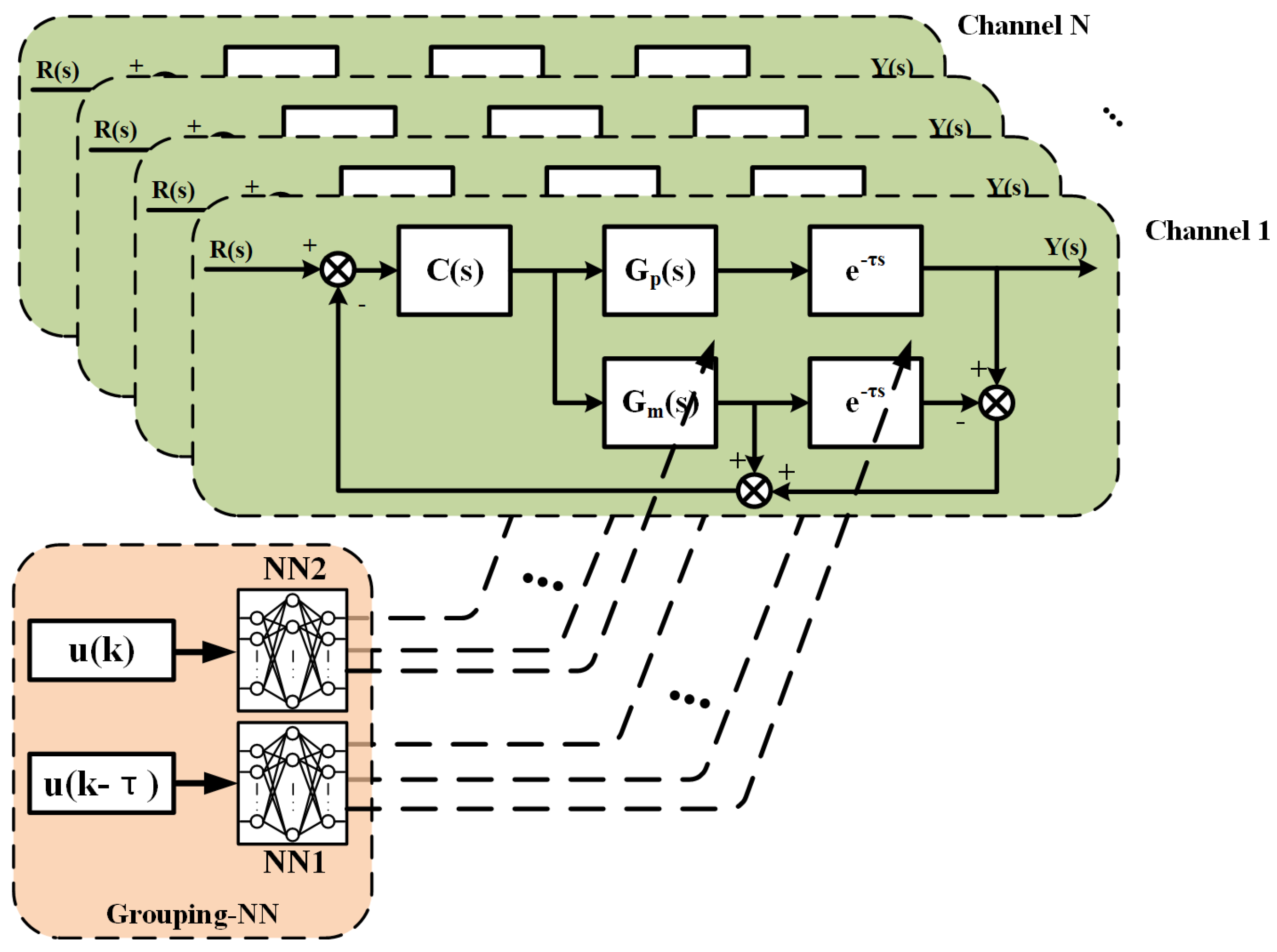
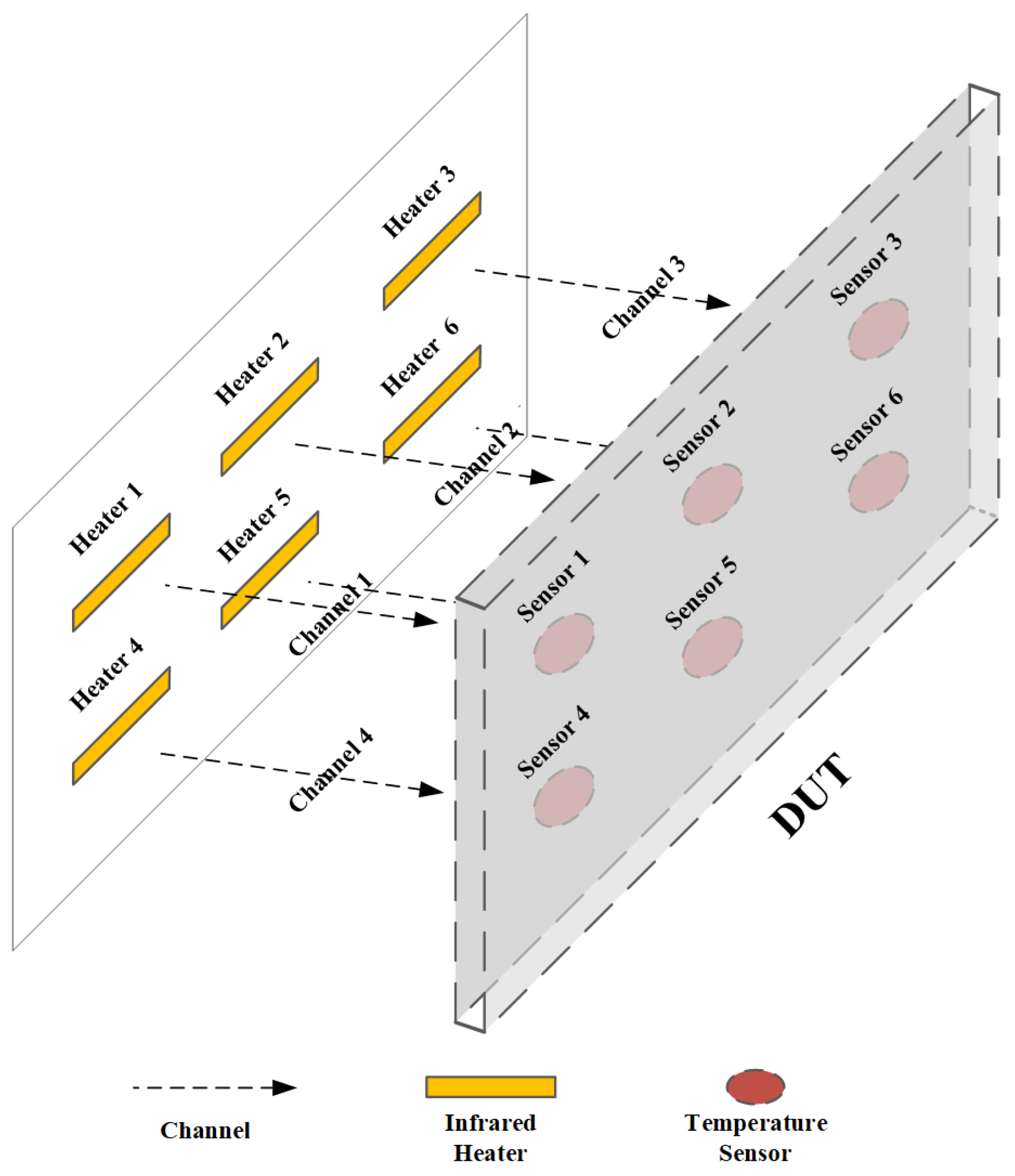
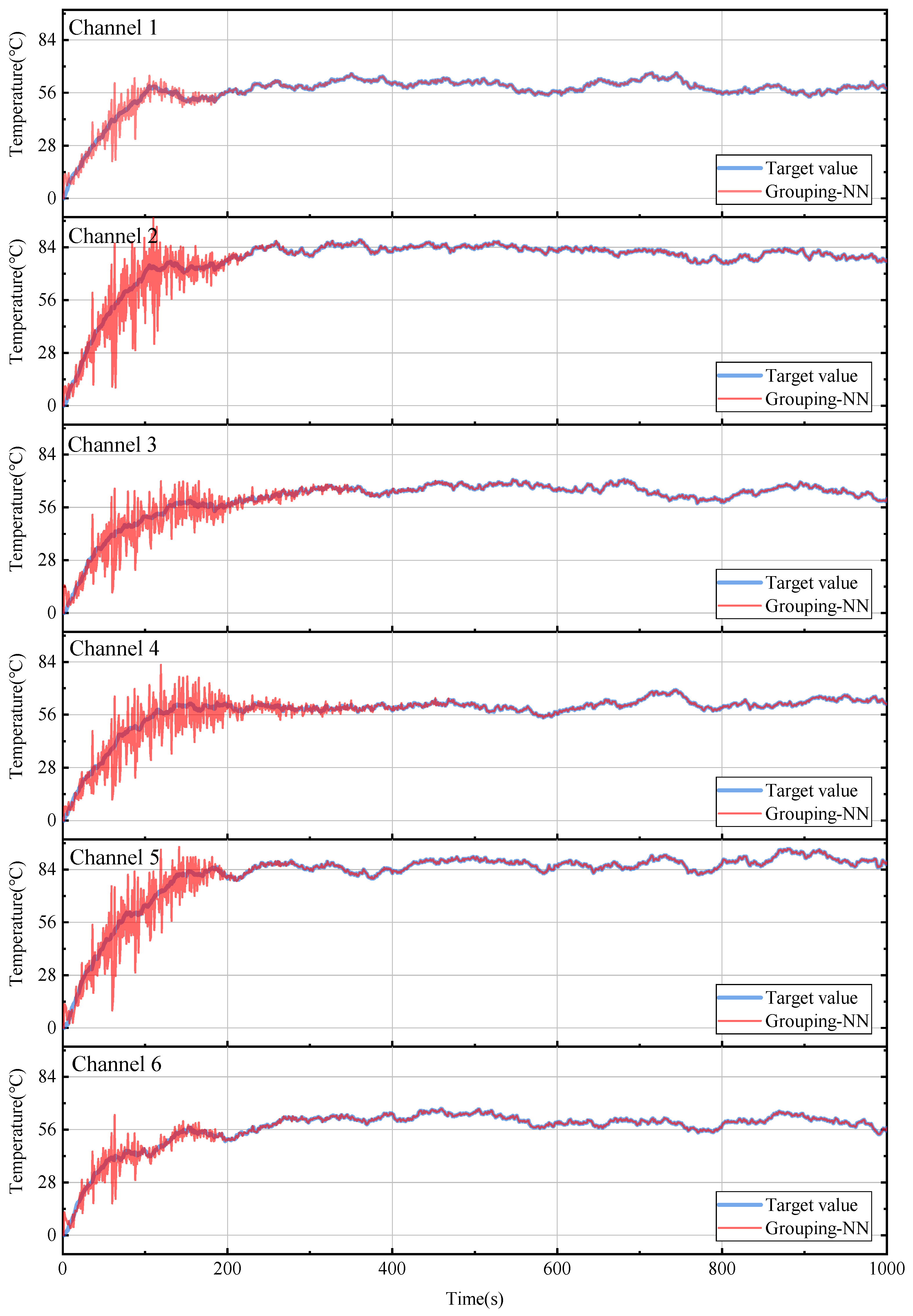


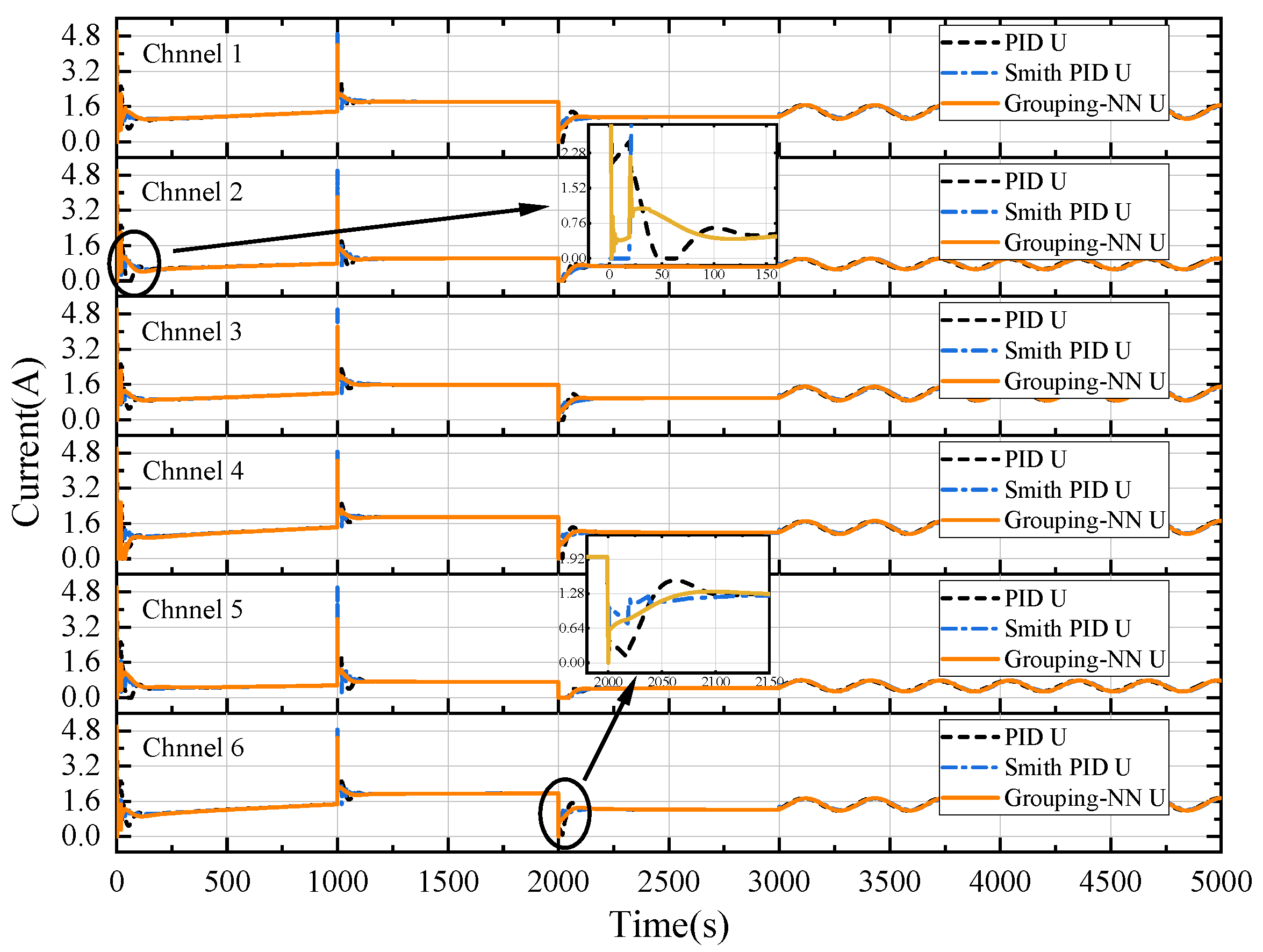
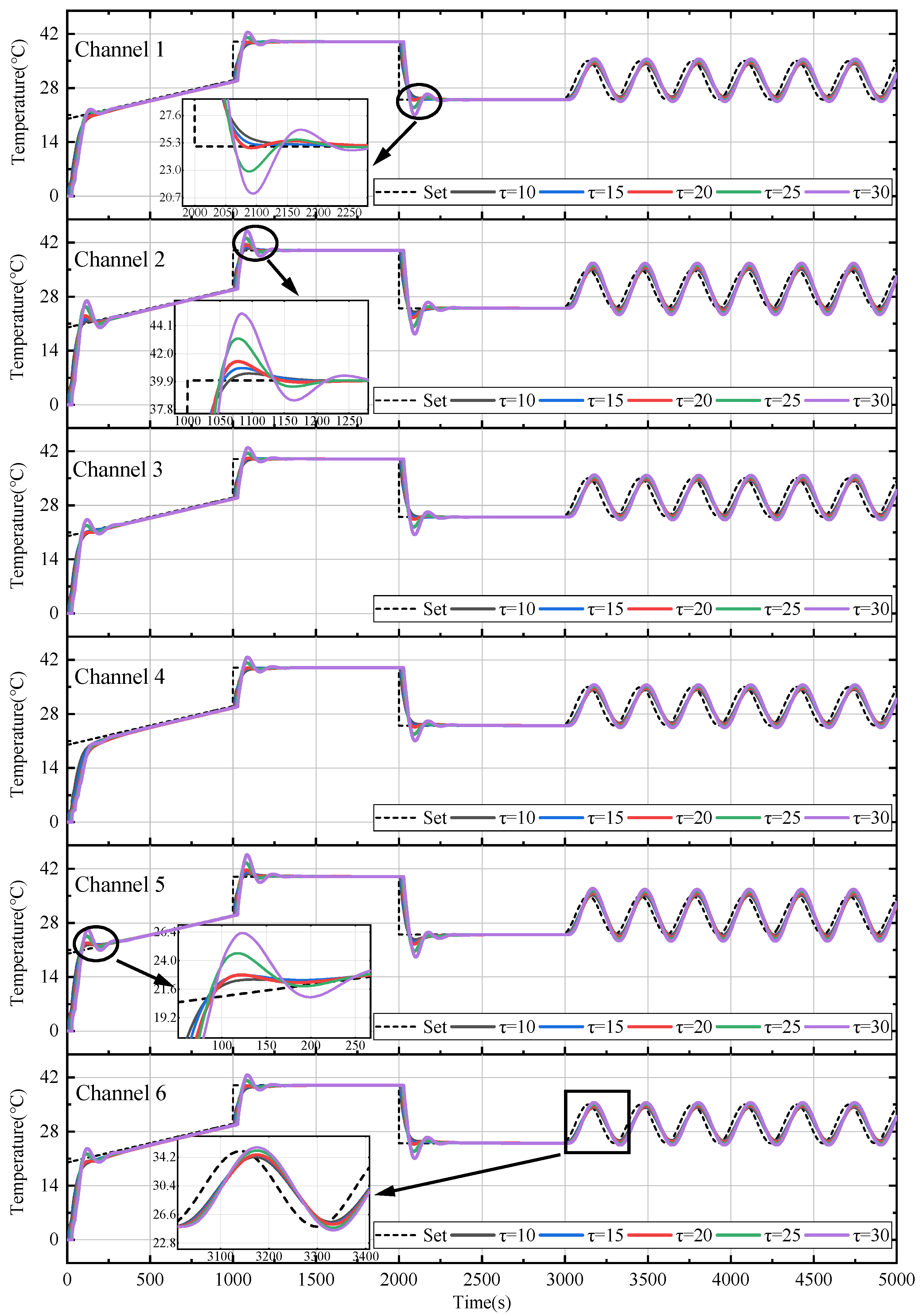
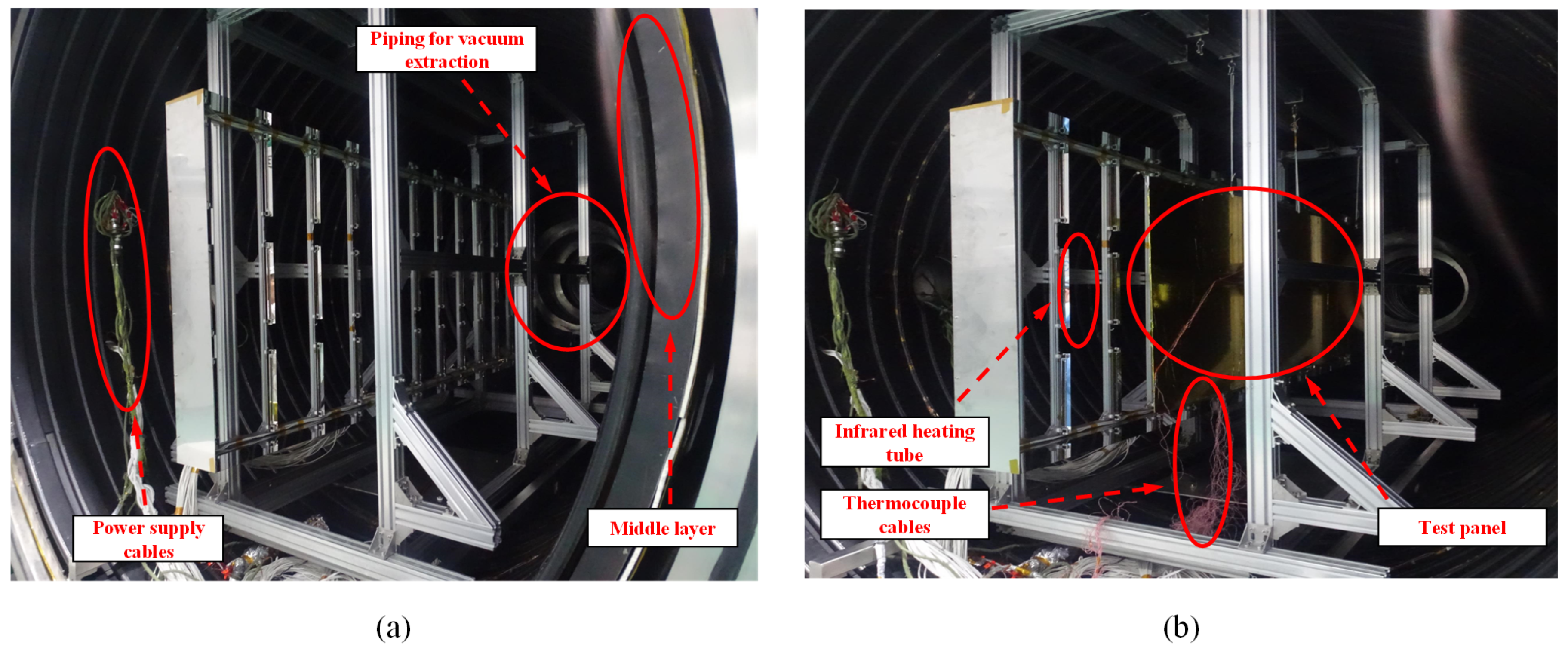

| Channel 1 | Channel 2 | Channel 3 | Channel 4 | Channel 5 | Channel 6 | |
|---|---|---|---|---|---|---|
| Avg (°C) | 0.037443 | 0.046753 | 0.036861 | 0.035849 | 0.040287 | 0.035392 |
| Condition 1 | Condition 2 | Condition 3 | Condition 4 | |
|---|---|---|---|---|
| Time (s) | 0–1000 | 1000–2000 | 2000–3000 | 3000–5000 |
| Set Value (°C) |
| Channel 1 | Channel 2 | Channel 3 | Channel 4 | Channel 5 | Channel 6 | ||
|---|---|---|---|---|---|---|---|
| PID | Condition 1 | 1.432 | 7.412 | 1.162 | 1.092 | 8.112 | 2.317 |
| Condition 2 | 0.837 | 3.817 | 1.243 | 1.118 | 4.206 | 1.212 | |
| Condition 3 | 1.6039 | 3.2811 | 1.93021 | 1.39131 | 2.0214 | 1.62766 | |
| Smith PID | Condition 1 | 0.423 | 2.743 | 1.025 | 0.382 | 3.144 | 0.202 |
| Condition 2 | 0.111 | 1.403 | 0.456 | 0.119 | 1.638 | 0.048 | |
| Condition 3 | 0.42951 | 2.6375 | 0.94365 | 0.66076 | 3.08603 | 0.5192 | |
| Grouping-NN PID | Condition 1 | 0 | 1.997 | 0 | 0 | 1.613 | 0 |
| Condition 2 | 0 | 1.415 | 0.09 | 0 | 1.715 | 0 | |
| Condition 3 | 0.05184 | 2.42311 | 0.53559 | 0.28183 | 2.41493 | 0.20145 |
| Overshoot (°C) | ||||||
|---|---|---|---|---|---|---|
| Channel 1 | Channel 2 | Channel 3 | Channel 4 | Channel 5 | Channel 6 | |
| Condition 1 | 0.302 | 1.276 | 0.443 | 0.199 | 2.059 | 0.148 |
| Condition 2 | 0.579 | 2.010 | 0.912 | 0.476 | 2.422 | 0.295 |
| Condition 3 | 0.736 | 3.339 | 1.459 | 0.789 | 4.095 | 0.338 |
| Steady-State Error (°C) | ||||||
|---|---|---|---|---|---|---|
| Channel 1 | Channel 2 | Channel 3 | Channel 4 | Channel 5 | Channel 6 | |
| Condition 1 | 0.1019 | 0.1261 | 0.1271 | 0.0922 | 0.1459 | 0.1069 |
| Condition 2 | 0.0718 | 0.1231 | 0.0888 | 0.1037 | 0.0852 | 0.0854 |
| Condition 3 | 0.0973 | 0.1079 | 0.0875 | 0.1102 | 0.0670 | 0.0897 |
| Settling Time (s) | ||||||
|---|---|---|---|---|---|---|
| Channel 1 | Channel 2 | Channel 3 | Channel 4 | Channel 5 | Channel 6 | |
| Condition 1 | 240 | 298 | 311 | 204 | 369 | 232 |
| Condition 2 | 312 | 293 | 323 | 248 | 356 | 295 |
| Condition 3 | 356 | 291 | 354 | 266 | 402 | 228 |
| Rise Time (s) | ||||||
|---|---|---|---|---|---|---|
| Channel 1 | Channel 2 | Channel 3 | Channel 4 | Channel 5 | Channel 6 | |
| Condition 1 | 119 | 91 | 105 | 121 | 84 | 123 |
| Condition 2 | 106 | 80 | 100 | 105 | 70 | 109 |
| Condition 3 | 106 | 80 | 99 | 103 | 81 | 105 |
Disclaimer/Publisher’s Note: The statements, opinions and data contained in all publications are solely those of the individual author(s) and contributor(s) and not of MDPI and/or the editor(s). MDPI and/or the editor(s) disclaim responsibility for any injury to people or property resulting from any ideas, methods, instructions or products referred to in the content. |
© 2024 by the authors. Licensee MDPI, Basel, Switzerland. This article is an open access article distributed under the terms and conditions of the Creative Commons Attribution (CC BY) license (https://creativecommons.org/licenses/by/4.0/).
Share and Cite
Li, F.; Yang, L.; Ye, A.; Zhao, Z.; Shen, B. Grouping Neural Network-Based Smith PID Temperature Controller for Multi-Channel Interaction System. Electronics 2024, 13, 697. https://doi.org/10.3390/electronics13040697
Li F, Yang L, Ye A, Zhao Z, Shen B. Grouping Neural Network-Based Smith PID Temperature Controller for Multi-Channel Interaction System. Electronics. 2024; 13(4):697. https://doi.org/10.3390/electronics13040697
Chicago/Turabian StyleLi, Fubing, Linhao Yang, Ao Ye, Zongmin Zhao, and Bingxia Shen. 2024. "Grouping Neural Network-Based Smith PID Temperature Controller for Multi-Channel Interaction System" Electronics 13, no. 4: 697. https://doi.org/10.3390/electronics13040697
APA StyleLi, F., Yang, L., Ye, A., Zhao, Z., & Shen, B. (2024). Grouping Neural Network-Based Smith PID Temperature Controller for Multi-Channel Interaction System. Electronics, 13(4), 697. https://doi.org/10.3390/electronics13040697






